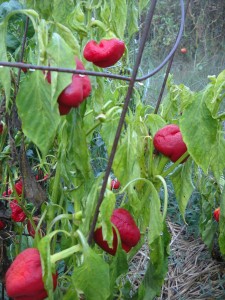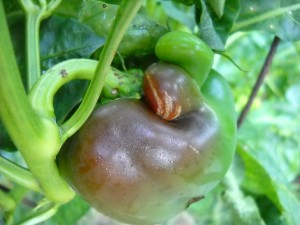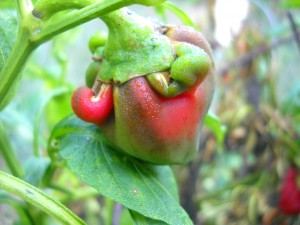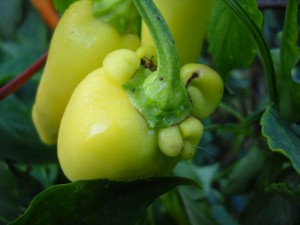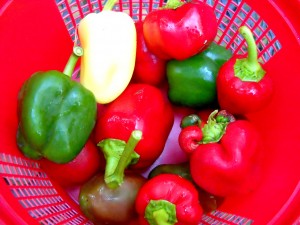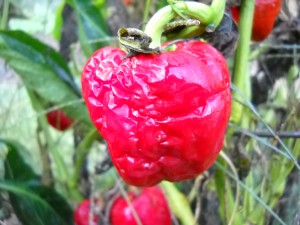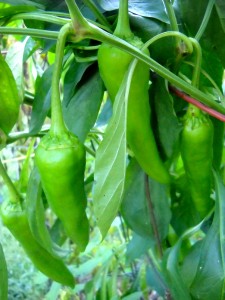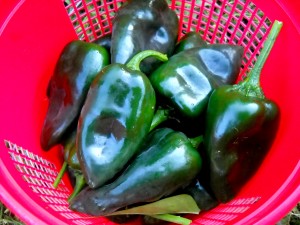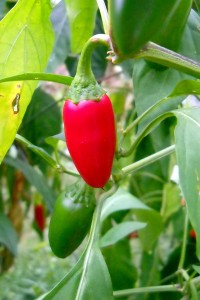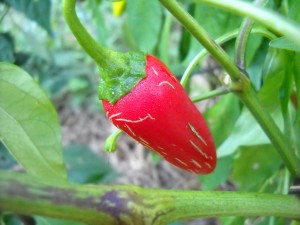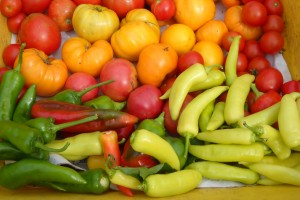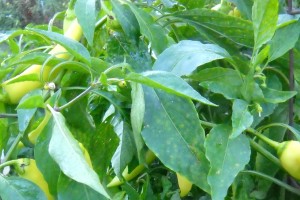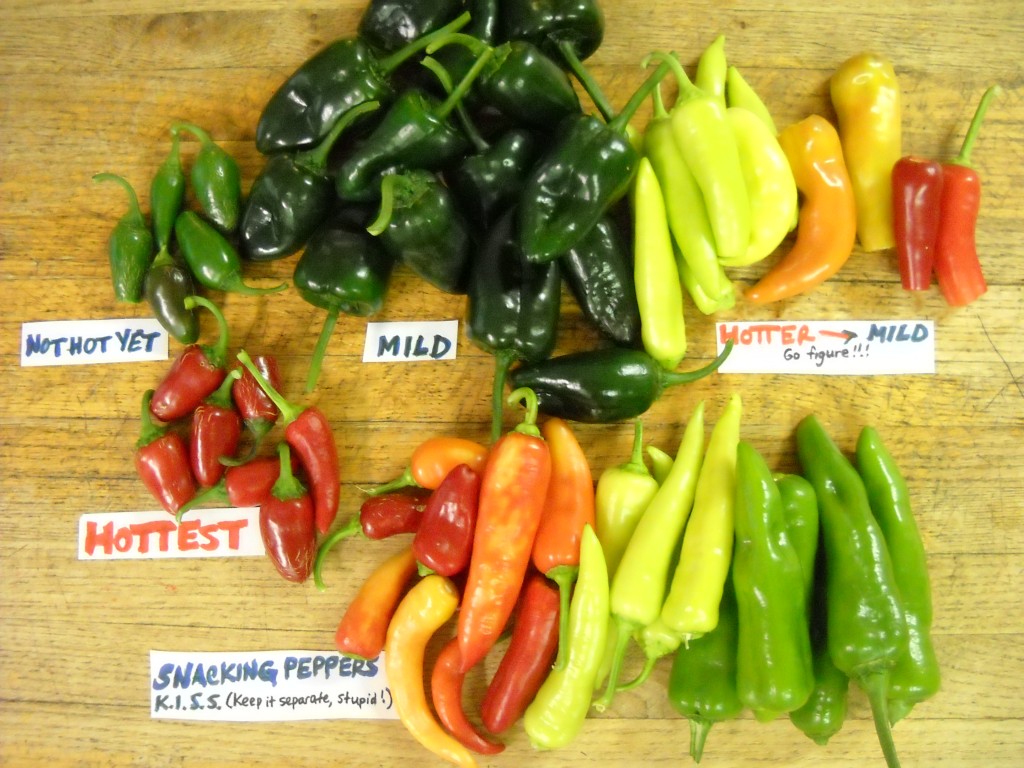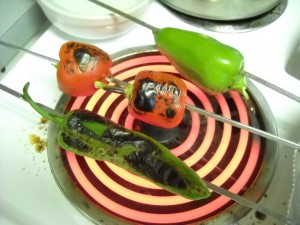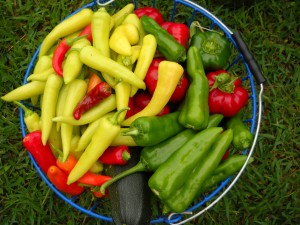Peppers for Dummies.
Posted on | October 3, 2015 | No Comments
The peppers got a new raised bed this year and it didn’t go well. About 1/3 of the bell pepper plants got green and glossy and then wilted.
Generally, wilted peppers are a sign of fungal disease. But since my peppers started out as lush plants, I suspected excessive nitrogen. The raised bed was layers of manure and mulched leaf debris and it only sat for about 4 months before planting. Which might not have been enough time for everything to break down and balance out. At least I hoped it was a nitrogen problem. The excessive nitrogen will fix itself over time. The fungus will require crop rotations or new soil. Of course, this was going on, too.
Vegetable deformities are usually blamed on pollination problems, but why would so many blossoms be pollinated improperly? Perhaps the excess nitrogen caused leaf development at the expense of proper blossom formation. Perhaps I planted the peppers too close together and there wasn’t enough air circulation or access for pollination. Perhaps the bell peppers hated the summer of 2015. Because even though they were prolific on the plants that didn’t have wilt, they were also really small.
At first I waited patiently for the smaller peppers to grow, hoping they just needed more time. More time just resulted in wrinkled, soft, and small bell peppers.
All of these problems made me glad that I planted a new variety of long green peppers. They did fine in the raised bed and were just as delicious as green bell peppers. Not as suitable for stuffed peppers but great for snacking or slicing. I’ll definitely be raising them again next year.
Actually, all of the long varieties of peppers did fine. Including the banana peppers and all the hot peppers. There was no reasonable explanation as to why the long peppers weren’t affected by excess nitrogen, fungal wilt, or pollination problems. After all, they shared the same raised bed. They were only inches away from the struggling and wilted bell peppers. There are no rules in the garden, people. No rules at all.
But the hot peppers had problems of their own. The most obvious problem was that I labeled them all as “hot” on their garden stakes. That’s it. No variety names, just “hot”. I figured they would be easy to recognize once they were ripe. Only the Poblanos were happy to oblige. They were beautiful, glossy, distinctively shaped peppers.
Of course, Poblano peppers can be left on the plant to age to a red color and then dried. At that point a Poblano becomes an “Ancho”, but the wide shape is still recognizable. In either form the pepper is mild, ranging between 1,000 and 1,500 Scoville heat units.
The other varieties of hot peppers were trickier. I finally decided that these were Jalapenos.
Jalapeno was my first guess because that’s exactly what they looked like to me. But when we tasted them we found out that the green ones were hardly spicy at all and the red ones were very spicy. Turns out that Jalapenos can run from 2,500 – 8,000 Scoville heat units, with the riper red ones being much closer to 8,000. Most people are familiar with the heat of a green Jalapeno but to get an idea of the heat difference between green and red Jalapenos, Sriracha sauce is made with red Jalapenos. Also, “Chipotle” peppers are dried red Jalapenos. So Chipotle sauces and products are hotter than green Jalapenos, although the smoking during the drying process accounts for the smoky intense flavor that tempers the heat a bit.
To add to the heat confusion of Jalapenos, some people told me the striations on the peppers meant more heat.
Those striations are actually called “corking” and the jury is still out on whether that signals a hotter pepper or not. Officially, the marks are just a sign that the pepper grew faster than the skin, essentially leaving stretch marks (a self-explanatory process for all mothers out there). Peppers with corking are usually the older, more mature peppers on the plant so that may account for anecdotal evidence that they are hotter than other peppers. But no one really knows if corking is relevant and I couldn’t get enough kids willing to bite into red Jalapenos to run a taste test at home.
The biggest problem was with these guys.
In the process of picking produce one afternoon, I tossed all the long peppers into the bottom of the wheelbarrow. I mistakenly thought the long yellow, orange, and red ones were just banana peppers or the Lunchbox Snack Peppers I got from Johnny’s seeds. Until I sliced them to put in a salad and discovered some of them were the hottest peppers we had in the garden. Not all banana peppers or snacking peppers. Not.
I went back down to the garden to check the stakes hidden under the leafy branches and discovered one of the plants next to the banana peppers was labeled “hot”. Even though it looked like it had banana peppers on it.
There were only 2 choices for banana pepper look-alikes—-either Anaheim or Hungarian Wax Peppers. Since Anaheim peppers are mild I knew it had to be the Hungarian Wax Peppers with a range between 5,000 – 10,000 Scoville heat units. But then the garden really threw out the rules. Because the orange or red Hungarian Wax Peppers that we harvested were more mild than the bright green ones. Which can’t happen. Can’t. Because, as I mentioned earlier, the riper and more mature peppers should be hottest. Capsaicin is the component in peppers that makes them taste hot and the amount of capsaicin in a pepper increases as it ages. The largest amount of capsaicin is found in the white pithy part of the pepper that hold the seeds. But my red and orange Hungarians Wax peppers were far more mild than the yellow ones. Even when I held the plants far apart while picking to make sure I wasn’t putting snack peppers in the mix. Weird.
While I was researching the amount of capsaicin in peppers I discovered that the hot peppers might have been flourishing next to the wilted bell peppers because the increased capsaicin in spicier peppers also acts as an anti-fungal. That was bad news in support of fungus killing off the mild bell peppers in the raised bed. But it didn’t explain why the long green bell peppers were doing fine, even though they weren’t spicy.
Sometimes there are no answers. But there are still solutions. I made myself a handy guide to keep everything straight, took a picture, and loaded it onto the computer for future reference.
Then we roasted a bunch of peppers over the stove.
And made a nice pizza with homemade marinara and roasted peppers from the garden.
Oh, yeah, plus some venison sausage on top, too. Because peppers aren’t the only thing in season around here.
The first buck of the season goes to Pretty. Time to get out the pressure canner. Looks like we’ll be stocking the pantry with plenty of canned venison and canned roasted peppers this year.
Oh, and did someone say “roasted jalapeno sauce“? Pepper up, people. Pepper up!
Comments

Leave a Reply
